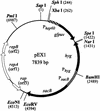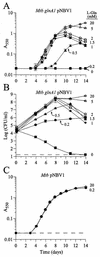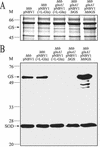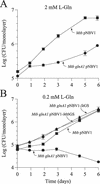Glutamine synthetase GlnA1 is essential for growth of Mycobacterium tuberculosis in human THP-1 macrophages and guinea pigs
- PMID: 12819079
- PMCID: PMC162033
- DOI: 10.1128/IAI.71.7.3927-3936.2003
Glutamine synthetase GlnA1 is essential for growth of Mycobacterium tuberculosis in human THP-1 macrophages and guinea pigs
Abstract
To assess the role of glutamine synthetase (GS), an enzyme of central importance in nitrogen metabolism, in the pathogenicity of Mycobacterium tuberculosis, we constructed a glnA1 mutant via allelic exchange. The mutant had no detectable GS protein or GS activity and was auxotrophic for L-glutamine. In addition, the mutant was attenuated for intracellular growth in human THP-1 macrophages and avirulent in the highly susceptible guinea pig model of pulmonary tuberculosis. Based on growth rates of the mutant in the presence of various concentrations of L-glutamine, the effective concentration of L-glutamine in the M. tuberculosis phagosome of THP-1 cells was approximately 10% of the level assayed in the cytoplasm of these cells (4.5 mM), indicating that the M. tuberculosis phagosome is impermeable to even very small molecules in the macrophage cytoplasm. When complemented by the M. tuberculosis glnA1 gene, the mutant exhibited a wild-type phenotype in broth culture and in human macrophages, and it was virulent in guinea pigs. When complemented by the Salmonella enterica serovar Typhimurium glnA gene, the mutant had only 1% of the GS activity of the M. tuberculosis wild-type strain because of poor expression of the S. enterica serovar Typhimurium GS in the heterologous M. tuberculosis host. Nevertheless, the strain complemented with S. enterica serovar Typhimurium GS grew as well as the wild-type strain in broth culture and in human macrophages. This strain was virulent in guinea pigs, although somewhat less so than the wild-type. These studies demonstrate that glnA1 is essential for M. tuberculosis virulence.
Figures







Similar articles
-
All four Mycobacterium tuberculosis glnA genes encode glutamine synthetase activities but only GlnA1 is abundantly expressed and essential for bacterial homeostasis.Mol Microbiol. 2005 Nov;58(4):1157-72. doi: 10.1111/j.1365-2958.2005.04899.x. Mol Microbiol. 2005. PMID: 16262797
-
Low expression level of glnA1 accounts for absence of cell wall associated poly-l-glutamate/glutamine in Mycobacterium smegmatis.Biochem Biophys Res Commun. 2015 Mar 6;458(2):240-5. doi: 10.1016/j.bbrc.2015.01.079. Epub 2015 Jan 28. Biochem Biophys Res Commun. 2015. PMID: 25637529
-
Poly-L-glutamate/glutamine synthesis in the cell wall of Mycobacterium bovis is regulated in response to nitrogen availability.BMC Microbiol. 2013 Oct 11;13:226. doi: 10.1186/1471-2180-13-226. BMC Microbiol. 2013. PMID: 24112767 Free PMC article.
-
glnA Truncation in Salmonella enterica Results in a Small Colony Variant Phenotype, Attenuated Host Cell Entry, and Reduced Expression of Flagellin and SPI-1-Associated Effector Genes.Appl Environ Microbiol. 2018 Jan 2;84(2):e01838-17. doi: 10.1128/AEM.01838-17. Print 2018 Jan 15. Appl Environ Microbiol. 2018. PMID: 29150501 Free PMC article.
-
Nitrogen metabolism in mycobacteria: the key genes and targeted antimicrobials.Front Microbiol. 2023 May 18;14:1149041. doi: 10.3389/fmicb.2023.1149041. eCollection 2023. Front Microbiol. 2023. PMID: 37275154 Free PMC article. Review.
Cited by
-
ald of Mycobacterium tuberculosis encodes both the alanine dehydrogenase and the putative glycine dehydrogenase.J Bacteriol. 2012 Mar;194(5):1045-54. doi: 10.1128/JB.05914-11. Epub 2011 Dec 30. J Bacteriol. 2012. PMID: 22210765 Free PMC article.
-
Evidence, Challenges, and Knowledge Gaps Regarding Latent Tuberculosis in Animals.Microorganisms. 2022 Sep 15;10(9):1845. doi: 10.3390/microorganisms10091845. Microorganisms. 2022. PMID: 36144447 Free PMC article. Review.
-
Iron deficiency accelerates Helicobacter pylori-induced carcinogenesis in rodents and humans.J Clin Invest. 2013 Jan;123(1):479-92. doi: 10.1172/JCI64373. Epub 2012 Dec 21. J Clin Invest. 2013. PMID: 23257361 Free PMC article. Clinical Trial.
-
Mode-of-action profiling reveals glutamine synthetase as a collateral metabolic vulnerability of M. tuberculosis to bedaquiline.Proc Natl Acad Sci U S A. 2019 Sep 24;116(39):19646-19651. doi: 10.1073/pnas.1907946116. Epub 2019 Sep 9. Proc Natl Acad Sci U S A. 2019. PMID: 31501323 Free PMC article.
-
Mycobacterium tuberculosis PPE68 and Rv2626c genes contribute to the host cell necrosis and bacterial escape from macrophages.Virulence. 2016;7(1):23-32. doi: 10.1080/21505594.2015.1102832. Epub 2015 Nov 25. Virulence. 2016. PMID: 26605666 Free PMC article.
References
-
- Betteridge, P. R., and P. D. Ayling. 1976. The regulation of glutamine transport and glutamine synthetase in Salmonella typhimurium. J. Gen. Microbiol. 95:324-334. - PubMed
-
- Cole, S. T., R. Brosch, J. Parkhill, T. Garnier, C. Churcher, D. Harris, S. V. Gordon, K. Eiglmeier, S. Gas, C. E. Barry III, F. Tekaia, K. Badcock, D. Basham, D. Brown, T. Chillingworth, R. Connor, R. Davies, K. Devlin, T. Feltwell, S. Gentles, N. Hamlin, S. Holroyd, T. Hornsby, K. Jagels, B. G. Barrell, et al. 1998. Deciphering the biology of Mycobacterium tuberculosis from the complete genome sequence. Nature 393:537-544. - PubMed
-
- Cynober, L. 2002. Plasma amino acid levels with a note on membrane transport: characteristics, regulation, and metabolic significance. Nutrition 18:761-766. - PubMed
-
- Dall'Asta, V., P. A. Rossi, O. Bussolati, and G. C. Gazzola. 1994. Regulatory volume decrease of cultured human fibroblasts involves changes in intracellular amino-acid pool. Biochim. Biophys. Acta 1220:139-145. - PubMed
Publication types
MeSH terms
Substances
Grants and funding
LinkOut - more resources
Full Text Sources
Other Literature Sources
Molecular Biology Databases
Miscellaneous

